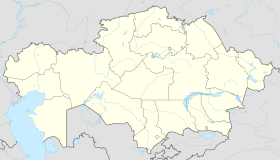Korgalzhyn (Kazakh: Қорғалжын, Qorğaljyn) is a village in the Akmola Region, Kazakhstan. It serves as the administrative center of Korgalzhyn District. The Nura River slowly flows around the selo. It is situated 120 km south-west of Astana. Population: 4,161 (2009 Census results);[1]5,717 (1999 Census results).[1]
Korgalzhyn
Қорғалжын Коргалжын | |
|---|---|
| Coordinates: 50°34.929′N 70°00.819′E / 50.582150°N 70.013650°E | |
| Country | |
| Region | Akmola Region |
The selo serves as the main and only base for entering the Saryarka — Steppe and Lakes of Northern Kazakhstan Unesco World Heritage site with Lake Tengiz at its heart. Many foreigners, mostly birdwatchers from all over the world come to the selo.
Climate
edit| Climate data for Korgalzhyn (1991–2020) | |||||||||||||
|---|---|---|---|---|---|---|---|---|---|---|---|---|---|
| Month | Jan | Feb | Mar | Apr | May | Jun | Jul | Aug | Sep | Oct | Nov | Dec | Year |
| Mean daily maximum °C (°F) | −11.5 (11.3) |
−10.0 (14.0) |
−2.5 (27.5) |
12.4 (54.3) |
21.4 (70.5) |
26.6 (79.9) |
27.7 (81.9) |
26.7 (80.1) |
19.7 (67.5) |
10.9 (51.6) |
−1.3 (29.7) |
−8.7 (16.3) |
9.3 (48.7) |
| Daily mean °C (°F) | −16.0 (3.2) |
−15.2 (4.6) |
−7.6 (18.3) |
6.0 (42.8) |
14.5 (58.1) |
19.8 (67.6) |
20.9 (69.6) |
19.5 (67.1) |
12.6 (54.7) |
4.7 (40.5) |
−5.3 (22.5) |
−13.0 (8.6) |
3.4 (38.1) |
| Mean daily minimum °C (°F) | −20.6 (−5.1) |
−20.2 (−4.4) |
−12.4 (9.7) |
0.3 (32.5) |
7.6 (45.7) |
12.9 (55.2) |
14.4 (57.9) |
12.5 (54.5) |
6.0 (42.8) |
−0.4 (31.3) |
−9.3 (15.3) |
−17.5 (0.5) |
−2.2 (28.0) |
| Average precipitation mm (inches) | 19.2 (0.76) |
20.1 (0.79) |
19.3 (0.76) |
17.6 (0.69) |
24.4 (0.96) |
40.6 (1.60) |
38.5 (1.52) |
25.4 (1.00) |
20.1 (0.79) |
24.7 (0.97) |
23.7 (0.93) |
23.6 (0.93) |
297.4 (11.71) |
| Average precipitation days (≥ 1.0 mm) | 5.4 | 5.1 | 4.5 | 4.0 | 5.3 | 6.2 | 6.7 | 4.4 | 3.9 | 5.0 | 5.5 | 6.1 | 62.1 |
| Source: NOAA[2] | |||||||||||||
References
edit- ^ a b "Население Республики Казахстан" [Population of the Republic of Kazakhstan] (in Russian). Департамент социальной и демографической статистики. Retrieved 8 December 2013.
- ^ "World Meteorological Organization Climate Normals for 1991-2020 — Korgalzhyn". National Oceanic and Atmospheric Administration. Retrieved January 2, 2024.
